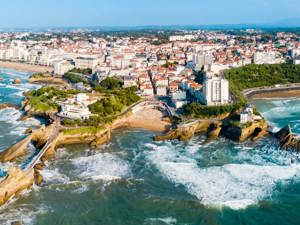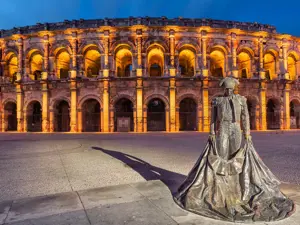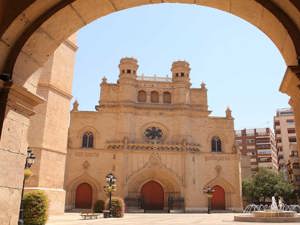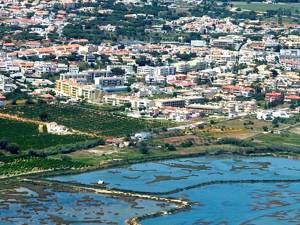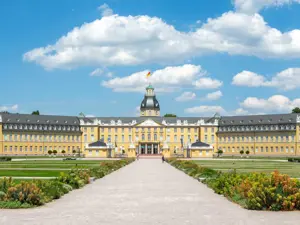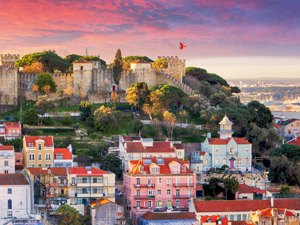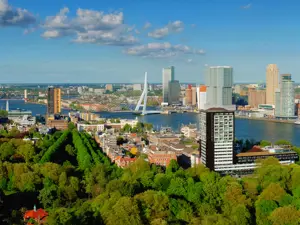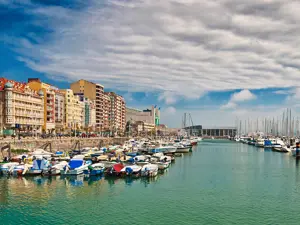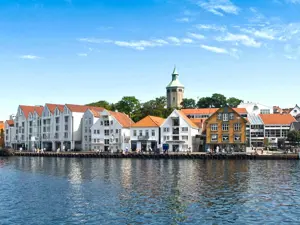A fascinating spiritual destination
Lourdes, the primary city of pilgrimage in Europe after Rome, each year welcomes millions of visitors. It is known throughout the world as a holy place where, in 1858, the Virgin Mary appeared 18 times in a cave near the river to Bernadette Soubirous, a young 14-year-old girl from Lourdes. After commemorating the 160th anniversary of the apparitions in 2018, 2019 marks the 175th anniversary of the birth of Bernadette and the 140th anniversary of her death.
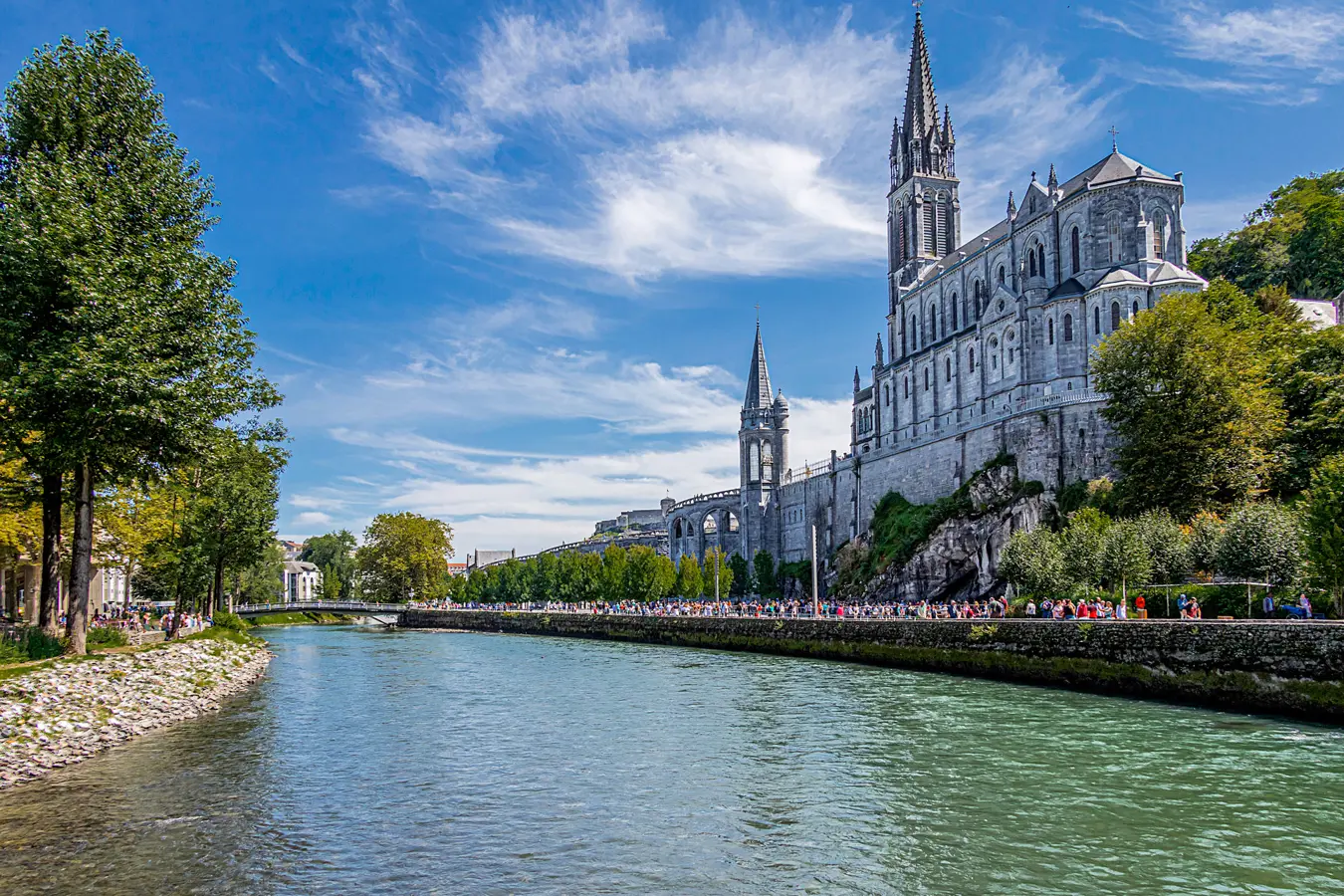
Basilica of the Immaculate Conception. Photo: Copyright © Jacky D / Sisterscom.com / Shutterstock
The Basilica of the Rosary, built in a style influenced by Romanesque-Byzantine architecture, is covered in Venetian mosaics depicting the five “Luminous Mysteries”, which were added to the traditional mysteries by Pope John Paul II, who went on pilgrimage to Lourdes twice. The Basilica of the Immaculate Conception, built in thirteenth-century Ogival style, is reached along the ramps at the edge of the square.
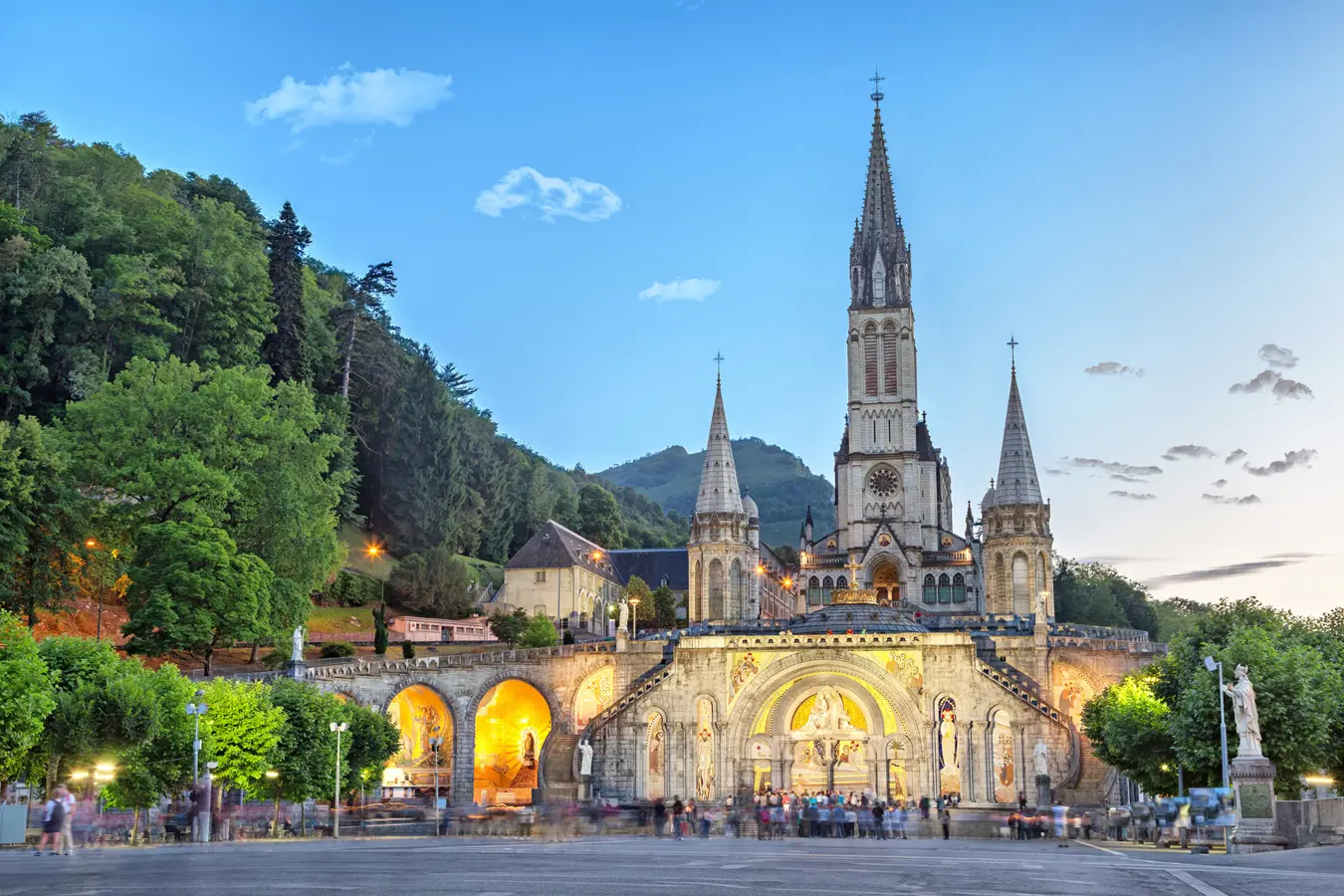
Basilica of the Rosary. Photo: Copyright © Sisterscom.com / Shutterstock
From the square of the Sanctuary, pilgrims can choose three directions: visit the Basilica of the Rosary, walk up the ramps to the Basilica of the Immaculate Conception or visit the Cave.
Pilgrims, on reaching St. Michael’s Gate, are deeply moved by the Sanctuary of Our Lady of Lourdes, which is dominated by the spire of the bell tower surmounted by a crucifix that appears on the horizon. The square where pilgrims meet is a wide-open space with a statue of the Virgin Mary and the two basilicas: Basilica of Our Lady of the Rosary in the middle of the trees, and the Basilica of the Immaculate Conception, also known as the Upper Basilica.

Basilica of the Rosary. Photo: Copyright © Semmick / Sisterscom.com / Shutterstock
Visitors can walk under the elliptical ramps, which represent the loving arms of the Virgin Mary, through seven arches inspired by Bernini’s columns in St. Peter’s Square in Rome, between the square and the cave. After walking under the arches, pilgrims can drink from the fountains and head towards the Cave of the Apparitions or Massabielle Cave, which is open even at night and holds the Spring dug by Bernadette on the Virgin Mary’s instructions, which feeds the fountains and pools.

Cave of the Apparitions or Massabielle Cave. Photo: Copyright © by-studio / Sisterscom.com / Shutterstock
Visitors can file through the shallow cave under the basilica in a line, touching, stroking and kissing the cave walls in a religious, superstitious and magical atmosphere.
For each pilgrim, the most important moment of the day in Lourdes takes place every evening when thousands of worshippers and visitors get together to walk in a procession behind a Statue of the Madonna of Lourdes, each holding a burning torch. The procession, which is spontaneous and filled with spiritual energy, moves from the cave to the Basilica of Our Lady in a spectacle of light.

Procession of pilgrims. Photo: Copyright © DyziO / Sisterscom.com / Shutterstock
Outside the Sanctuary area, a welcome is assured in the city, which is easily visited on foot to discover the numerous cultural attractions among the streets of the old town, the Fontaine des trois becs, the medieval Gavarnie Tower, the Saint-Jean river promenade, Rue des Espenettes and the historic “Chemin de Bernadette”, illustrated with signs to the Boly Mill, the birthplace of Bernadette. Visitors can then cross the River Gave on the Old Bridge or Saint-Michel Bridge and climb up to the old town to the ancient Château Fort, built on a rocky outcrop and reached with a lift on Rue du Fort.

Château Fort. Photo: Copyright © Sisterscom.com / Shutterstock
Don’t miss the viewpoints from the fourteenth-century fortified tower, the Botanical Garden and terrace, which overlooks the city (Pointe du Cavalier), the Sanctuary and the Pyrenees.

Pic du Midi de Bigorre. Photo: Copyright © Sisterscom.com / Shutterstock
In addition to the essential visit to the Sanctuary, different spiritual and mystical experiences can be enjoyed in Lourdes and its surroundings even by simply gazing at nature in the area, including the Gave de Pau River, which runs from the mountains towards the city, the Cirque de Gavarnie Glacier, which is on UNESCO’s list, the Pic du Midi de Bigorre, the Pyrenees National Park and the Néouvielle Nature Reserve, the numerous lakes, rivers and waterfalls of the High Pyrenees.
Text by Nicolò Villa
Copyright © Sisterscom.com
Video: www.lourdes-infotourisme.com
Tourism Board
www.lourdes-infotourisme.com
Partnership with Booking.com
Where to sleep in Lourdes

Lourdes. Photo: Copyright © Shutterstock
Lourdes is a welcoming city and offers different possibilities for accommodation.
To find the ideal hotel and the best offers you can do a search for the stars but also for districts or landmarks.
LANDMARKS
Hotels in tourist areas
WHERE TO GO in lourdes
Monuments and Museums in Lourdes

Photo: Copyright © Shutterstock
SANCTUARY OF OUR LADY OF LOURDES
In the Sanctuary of Our Lady of Lourdes you can visit: the Crypt, the Basilica of the Immaculate Conception (Basilica Superiore), the Basilica of the Rosary and the Basilica of San Pio X.
The windows of the Basilica of the Immaculate Conception trace history of the Virgin Mary. While the Basilica of the Rosary, in Romanesque-Byzantine style, contains Venetian mosaics covering an area of 2000 m2. The Basilica of San Pio X is located in the basement and houses portraits that represent different saints and blessed.

Photo: Copyright © Shutterstock
GROTTO OF THE APPARITIONS OF LOURDES
The Grotto of Massabielle is the place where, in 1858, the Virgin appeared to Bernadette Soubirous. Here is located the Spring uncovered by Bernadette from the suggestion of the Virgin. The Spring feeds the water's path, the fountains and the pools. On the right side of the Grotto you can discover the Fountains and drink the water of Lourdes. From here you can go to the Swimming Pools of the Sanctuary to immerse yourself in the water from the Spring. Opposite the Grotto, on the other side of the Gave de Pau river, stands the Chapel of Lights where pilgrims go to light a candle.

Photo: Copyright © Shutterstock
FORTRESS OF LOURDES
Château Fort is a thousand-year-old fortress and offers exceptional views of the city, the Sanctuaries and the Pyrenees. Within its walls there is also a Botanical Garden and the Pyrenean Museum.

Photo: Copyright © Shutterstock
HAUSE-MUSEUM OF BERNADETTE
Bernadette Soubirous was born in 1844 at the Boly Mill which can be visited to see the room where Bernadette was born, the kitchen and the old mill. Also don’t miss: Le Cachot and the Museum of Sainte Bernadette near the Sanctuary.
Excursions in Lourdes

Photo: Copyright © Shutterstock
PIC DU JER
The Pic du Jer dominates the city of Lourdes and is accessible through a centuries-old funicular. From the summit, which culminates at 900 meters above sea level, you can admire a beautiful view of the Pyrenees, Lourdes, Tarbes, Pau, the Valley of Argelès-Gazost. The Pic du Jer is the ideal place to admire the underground caves, go for walks along botanical paths, nature walks, outdoor activities and for mountain bike enthusiasts. For relaxation, you can stops at the Le Haute de Lourdes bar-restaurant.

Photo: Copyright © Shutterstock
PYRENEES NATIONAL PARK
The Pyrenees National Park, created in 1967, is a natural heritage of majestic landscapes with mountains, valleys, wild animals, pastures, trees and flowers of unique beauty, such as the Pyrenean violet, yellow lily and the blue Pyrenean thistle. The park is home to stoats, wild boar and foxes and protected animals such as the Pyrenean chamois (Isard), marmot and brown bear. The park can be visited on foot along paths and routes among nature, but also by cable car or chairlifts, which lead to the mountain huts.

Photo: Copyright © Shutterstock
CIRQUE DE GAVARNIE
The Cirque de Gavarnie, with rocks sculpted by an ancient glacier in the valley and the highest waterfall in Europe, is on UNESCO’s World Heritage list. To see the glacial cirque, after crossing the town of Gavarnie, a round trip takes about 3 hours on foot or on the back of a donkey or pony. Back in the town, well worth a visit is the Church of St. John the Baptist, a UNESCO World Heritage Site on the “Santiago di Compostela” routes, which was built in the thirteenth century.

Photo: Copyright © Shutterstock
PIC DU MIDI DE BIGORRE
Pic du Midi is a mountain in the Pyrenees. Two cable cars take visitors from the town of La Mongie over 1,000 metres in 15 minutes to the terraces on the Pic du Midi (2,877m), which offer views over La Brèche du Roland and the tête d’ours of the Pic du Midi d’Ossau. At the top there are a museum and the planetarium, under the Baillaud dome. Visitors can learn all about the history of the Pic du Midi Observatory, enjoy the experience of the “pontoon in the sky”, dine under the stars or stay the night.

Photo: Copyright © Shutterstock
CAUTERETS PONT D’ESPAGNE
In the heart of the Pyrenees National Park, Cauterets with the Pont d’Espagne (1,496 m) is a natural area with waterfalls in the High Pyrenees and two valleys that can be explored on foot: the Marcadau Valley and the Gaube Valley with its lake that can also be reached by chairlift. A cable car takes visitors to the Clot Plateau, while the chairlift arrives at Gaube Lake, at the foot of Pic du Vignemale (3,298 m). Here visitors can enjoy a picnic next to the lake or have lunch at the Hôtellerie du Lac. Even the centre of Cauterets is worth a visit for the architecture.

Photo: Copyright © Shutterstock
OUTDOOR ACTIVITIES
The water courses around Lourdes are ideal for lovers of outdoor activities to enjoy water sports such as rafting, canoeing or kayaking. Lourdes Lake, of glacial origin and 3 km from the city centre, is perfect for mountain bike rides, fishing, golf and, in summer, horse riding.
Instead, trekking or hiking, walking in the fresh air among the fields, forests and paths of the Pyrenees brings visitors up close to nature. Expert climbers can scale the high peaks of the Pyrenees.

Photo: Copyright © Shutterstock
TARBES
The city of Tarbes is home to Tarbes-Lourdes-Pyrénées Airport and is situated less than an hour from the Pyrenees and 20 km from the town of Lourdes. Among the tourist attractions of historical and cultural interest are the Cathedral of Notre Dame de la Sède, the gothic Church of Saint Jean, the Church of St. Therese in Marcadieu Square with the monumental fountain of Quatre-Vallées, Verdun Square, the Théâtre des Nouveautés, built in 1885 in Italian style, the Massey Garden and the Massey Museum.

Photo: Copyright © Shutterstock
PAU
In the heart of the Pyrenees, the city of Pau is located about 30 minutes from Lourdes. Pau is a city rich in history with the Castle of Pau, where King Henry IV of France was born, the Museum of Fine Arts, the Bernadotte Museum, the Haras de Pau Gelos or the beautiful architecture of the Church of San Martino, the Parliament of Navarre and the Beaumont Palace. The center of Pau is pleasant to travel on foot or by bicycle. Pau is also a green city with many parks and gardens and offers spectacular views of the Pic du Midi of Ossau and the Pyrenees.
Partnership with GetYourGuide
Recommended tours in Lourdes

Photo: Copyright © Shutterstock

Photo: Copyright © Shutterstock
Discover all tours
You might be interested in
Other destinations
Airports nearby Lourdes



